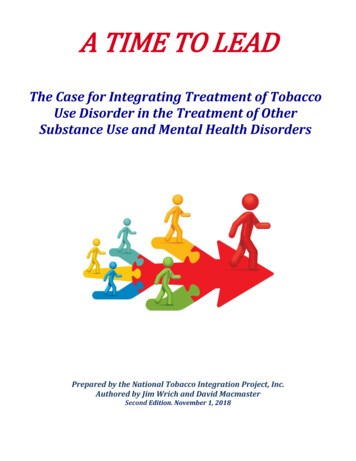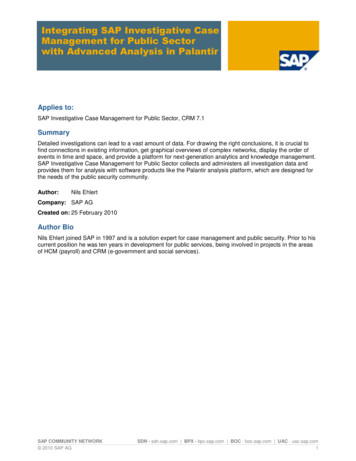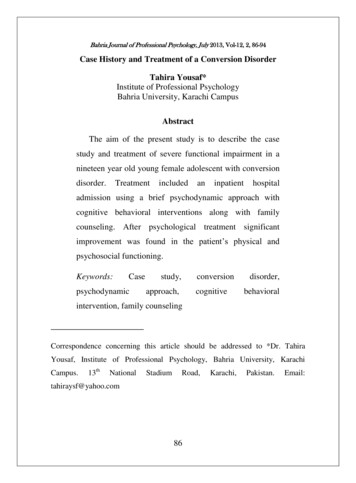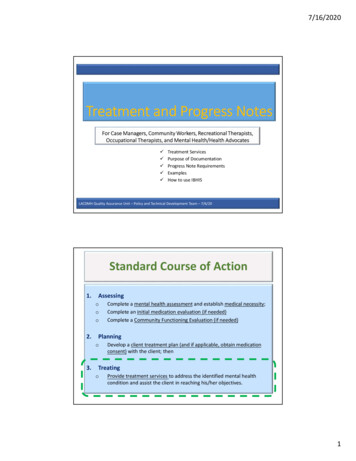
Transcription
A TIME TO LEADThe Case for Integrating Treatment of TobaccoUse Disorder in the Treatment of OtherSubstance Use and Mental Health DisordersPrepared by the National Tobacco Integration Project, Inc.Authored by Jim Wrich and David MacmasterSecond Edition. November 1, 2018
NATIPNational Tobacco Integration ProjectA Time to LeadThe Case for Integrating Treatment of Tobacco Use Disorderin the Treatment of Other Substance Useand Mental Health Disorders “A Time to Lead” is an appeal for action. Its purpose is to bring to light the urgent need tointegrate evidence-based treatment of Tobacco Use Disorder (TUD)1 into the protocols fortreating substance use and mental health disorders in the United States. “A Time to Lead” exposes a huge gap in addiction and mental health services. It reveals thatcurrent practices accept the preventable diseases and death from tobacco of more than 200,000Americans within these two vulnerable populations that account for nearly 40% of the 540,000annual tobacco deaths in the US. Few people live in isolation, including tobacco users. Anecdotally, we assume that four people aredirectly involved with tobacco users. On this basis the annual collateral damage from this servicegap affects more than 800,000 family members and acquaintances who suffer the loss of lovedones, many of whom successfully battled substance use and mental disorders only to die fromtobacco related health problems. The 80% of SUD treatment patients who smoke are victims of discrimination as they are deniedTobacco Use Disorder (TUD) treatment services that are well within the capacity of theaddictions treatment system to provide and that are, in fact, routinely offered to patients treatedwith other substance use disorders. While exposing this major flaw in service philosophy, “A Time to Lead” also offers realistic andachievable recommendations for closing the gap. These recommendations are endorsed byleading US experts on tobacco, mental health and addictions who comprise the NATIAC. Most importantly, “A Time to Lead’ demonstrates beyond doubt that this service gap is not due tolack of expertise, resources or ability to effectively eliminate it. The problem has been a lack ofwillingness of key parties, particularly the addictions treatment providers.The DSM-5 uses the term “Tobacco Use Disorder” which consists of a number of tobacco related health issues,including addiction to nicotine.1
NATIACThe National Tobacco Integration Advocacy CouncilDavid Macmaster, CSAC, PTTS, CoordinatorJim Wrich, Project DirectorFounding NATIAC MembersBruce Christiansen, PhD Senior Scientist, University of Wisconsin, School of Medicine and PublicHealth, Center for Tobacco Research & Intervention. He is Coordinator and Co-founder of WisconsinNicotine Treatment Integration Project (WINTIP). He developed the Wisconsin tobacco integrationguidelines for implementing 100% tobacco free environment, providing evidence-based nicotinedependence treatment and assisting staff to be tobacco free in support of a tobacco free recoveryenvironmentEric Heiligenstein, MD Psychiatrist at Journey Mental Health Center, Madison, Wisconsin, MedicalDirector and Co-founder of Wisconsin Nicotine Treatment Integration Project (WINTIP) and amember of the Wisconsin Tobacco Advisory Board. He is involved at the state and national levels inintegrating tobacco prevention and intervention into mental health and substance use treatmentpractices.Norm Hoffman, PhD Founder and president of Evince Clinical Assessments. He develops clinicalassessment instruments and provides consultation and training on a broad range of health issues inthe behavioral health area. Dr. Hoffman was founder and President of CATOR (ComprehensiveAssessment and Treatment Outcomes Research); developed the Cleveland Criteria, and was leadauthor of the initial ASAM Clinical placement Criteria for the treatment of Substance Use Disorders.He is an international authority on addiction assessment and research.Tony Klein, MPA, CASAC, NCAC II Manager of Outpatient Chemical Dependency Services, UnityHospital of Rochester/Unity Chemical Dependency. Well known as an advocate for addressingtobacco in addiction services, he assisted with the development, drafting, training andimplementation of New York State Regulation 856-Tobacco-Free Services. He lectures nationallyand provides consultation to community providers on recovery-oriented tobacco strategies.David Macmaster, CSAC, PTTS He was the inspiration for “A Time to Lead”. Managing Consultantand Co-founder of Wisconsin Nicotine Treatment Integration Project (WiNTiP). He developed thetobacco integration resolution that became state and national tobacco policy and was instrumentalin creating the Wisconsin tobacco integration guidelines. He is experienced in the application ofrecovery-oriented systems of care (ROSC) for substance use and mental health disorder clinicians,managers, consumers and allies.Michael Miller, M.D, FASAM, FAPA Past President of the American Society of Addiction Medicine(ASAM) and Medical Director of Rogers Memorial Hospital Herrington Recovery Center. He servedas Managing Editor for the 2013 edition of the ASAM Criteria, the most widely accepted manual ofutilization criteria for addiction care. He currently chairs the Action Group within ASAM thatproduces Standards of Care for the Addiction Specialist Physician.
Chad Morris, PhD Associate Professor, University of Colorado Department of Psychiatry andDirector Behavioral Health & Wellness Program. He is a member of the Society for Research onNicotine and Tobacco, a pioneer in tobacco integration in behavioral health professions and thedesign of tobacco integration manuals providing technical assistance, research and training.William Cope Moyers Vice President of Public Affairs, Hazelden-Betty Ford Foundation. Wellknown author and presenter of addiction topics and recovery community advocate and pioneer inremoving stigma and putting a positive face on recovery as a preferred public health strategy. He ishighly experienced in the dynamics and priorities of corporate health care systems.Karen Carpenter Palumbo Former Commissioner of the New York State Office of Alcoholism andSubstance Abuse Services (OASAS). She was responsible for implementing NYS’s 856 rule requiringall licensed addiction services to provide 100% tobacco free environments and to treat nicotinedependence concurrently with the treatment of other substance use disorders, a major publichealth achievement proving that tobacco integration is within the scope of practice for addictionprofessionals.Steven A. Schroeder, MD Director, Smoking Cessation Leadership Center and DistinguishedProfessor of Health and Health Care, Department of Medicine, University of California, SanFrancisco. He has worked to engage the mental health community in tobacco issues and wasPresident and CEO of the Robert Wood Johnson Foundation during which time the foundationgranted 4 billion in its pursuit of improving health for Americans.William White, MA Emeritus Senior Research Consultant at Chestnut Health Systems, past BoardChair of Recovery Communities United and volunteer consultant to Faces and Voices of Recovery.He is the author of “Slaying the Dragon: The History of Addiction Treatment and Recovery inAmerica”, and is widely recognized for leadership in the emerging concepts for recovery communityorganizations.Jill Williams, MD Professor of Psychiatry, Rutgers University, Robert Wood Johnson MedicalSchool, Division of Addiction Psychiatry. She is a national expert in treating tobacco dependence inpeople with behavioral health problems and provides annual training for behavioral healthprofessionals.Jim Wrich, BA The principal author of the document “A Time to Lead”. He is a pioneer in the fieldof Employee Assistance Programs (EAP) and managed care accountability. He is a past director ofthe Minnesota single state agency on Chemical Dependency. He has been engaged in programdevelopment for the Wisconsin Recovery Community Organization, conducted research andperformance reviews on managed care practices, and has more than 50 years experience inbusiness, government, politics, community activism and recovery advocacy.Past Founding NATIAC MemberSteven Kipnis, MD, FACP, FASAM Past Medical Director of the New York State Office of Alcoholismand Substance Abuse Services. He is a Diplomat American Board of Addiction Medicine. Along withHealth Commissioner Karen Carpenter Columbo, he drafted and implemented the NYS 856 tobaccointegration regulation and provided medical credibility for tobacco integration.
A Time to LeadThe Case for Integrating Treatment of Tobacco UseIn the Treatment of Other Substance UseAnd Mental Health DisordersIntroductionThe reduction in the rate of tobacco use in the USA has been dramatic. Having fallen from 42% ofthe adult population in 1964 to 18% by 20142 and down to 14% in 20173 it is one of the mostsignificant public health achievements since population-wide vaccination programs. However, dueto population growth, there are as many Americans dying from tobacco now as in 1964. Currentlymore than 540,000 US citizens die from tobacco related causes a year. 4 In 2010, when the tobaccomortality estimate was 435,000 it was estimated that roughly 200,000 5 suffered from othersubstance use and mental disorders6, a conservative number today considering the increasednumber of annual deaths.While efforts to reduce the absolute number of tobacco users in the general population shouldcontinue to be a primary public health objective, even more compelling is the need for a concertedeffort to reduce tobacco use among those who are “most-at-risk”, both for its use and its serioushealth consequences. A significant sub-group within this category are those currently being treated“Message from Howard Koh” Assistant Secretary for Health, US DHHS, 2014. Report of the USSG 2017Center for Disease Control and prevention, “Current Cigarette Smoking Among Adults in the United States. AP June19, 2018”www.cdc.gov/tobacco/campaign/tips4 Carter, BD; Abnet, CC; Feskanich, D. (2015) “Smoking and mortality-beyond established causes”, New England Journalof Medicine, 37, :631-40. Author’s Note: The CDC bases its estimate of 480,000 deaths on 21 tobacco related illnesswhereas Abnet, et al, include 30 illnesses, thus the higher estimate.5 Center for Disease Control, Steven A. Schroeder, MD: “Tobacco Dependence: A Grand Rounds Presentation” March 3,2010, Slide 14.6 Note: Public health language is evolving. As used in this document, the term “Behavioral Health” describes the mergingof psychiatry/mental health, alcoholism and addiction/substance use disorders into a single category.231
for other substance use disorders (SUD), with tobacco use estimates ranging upwards from 80%.7Many in this group have other co-morbid mental health issues8 which are also exacerbated bycontinued tobacco use.We believe a systemic effort to reduce tobacco use in these particular populations can be a keyfactor in bringing down the overall tobacco death toll in the USA. At the same time, the recoveryrates of those suffering from alcohol and other substance use disorders, mental/psychiatricdisorders, and a number of other health concerns can be improved.Transforming this hope into reality is entirely possible. However, it will require willingness on thepart of today’s SUD treatment providers to focus on and include treatment of Tobacco UseDisorders (TUD), much as was required by alcoholism treatment programs in the 1980s to addressaddiction to heroin, cocaine and a host of other drugs both licit and illicit. Such treatment is wellwithin the current capabilities of SUD treatment providers generally. In order to do this thedimensions of the problem must be acknowledged, a number of myths need to be examined,successful models of treatment cited, and the critical roles of stakeholders outlined.The Problem is MonumentalThe dimensions of the tobacco use problem are staggering. It affects practically every meaningfularea in the lives of all of us, not just those who smoke or use other tobacco products. It can beviewed from two perspectives: 1.) The effect on the general population, and 2.) The manner inwhich it exacerbates the problems of those suffering from other addictions. It is doubtful that apopulation with the ingenuity and drive of Americans would allow such a problem to persist if itwas not an addiction fraught with denial and misconceptions. Consider these facts:The General Population Tobacco related illnesses claim more American lives each year than were lost in World War IIand all other American wars since then combined. In 2017 more than five times as many diedfrom tobacco related illnesses as died from murder (17,250), suicide (44,965), traffic deaths(40,100), and AIDS (6,721), combined.9 While the subject of further research, anecdotally for every afflicted person dying from tobaccorelated causes an estimated four family members and close associates are affected and bear theburden of these losses. This computes to more than 2 million victims a year.Baca, C.T & Yahne, C.E., (2009). Smoking cessation during substance abuse treatment: What you need to know. Journalof Substance Abuse Treatment, 36, 205-219., and the New York State Office of Alcoholism and Substance Abuse Services,study of nicotine use prevalence among patients admitted for other substance use disorders.8 , Kessler, R.C., Chiu, W.T., Demier, O., & Walters, E.E., (2005). Prevalence, severity and comorbidity of 12 month DSMIV disorders in the National Comorbidity Survey replication. Archives of General Psychiatry, 62. 617-627.7“Message from Howard Koh” Assistant Secretary for Health, US DHHS, (2014). Report of the USSGAmerican Lung Association, Center for Disease Control and Prevention, US Department of Health andHuman Services, US Census Bureau; FBI Crime Statistics 2017 Report; CDC’s National Center for Health Statistics(Suicide); National Safety Council, Traffic Deaths, 2017; www.hiv.gov92
Since the first Surgeon General’s Report on Tobacco in 1964, more than 20 million Americanshave died from tobacco related illnesses.10 At current rates, 5.6 million of our children under age 18 will die prematurely from tobaccorelated illnesses.11 More than 40 million Americans are currently tobacco dependent with 3,200 new smokerslighting up each day and 2 100 increasing their use from occasional to daily.12 The costs of tobacco related illnesses and lost productivity are huge: The DHHS estimates thetotal at 289 billion annually with 133 billion in medical care and 156 billion in lostproductivity13, more than 5 billion of which is due to second hand smoke. Adjusted forinflation, this projects to more than 3 trillion over the next ten years.The Substance Use Disorder Population Tobacco related illnesses claim more than 3 times as many lives as alcohol (88,000)14, legal andillegal drug use (66,632) combined.15 It is reported that those with substance use and mental health disorders account for 44% of thecigarettes smoked in the USA16 resulting in more than 200,000 annual preventable deaths inthese high risk populations.17 The prevalence of tobacco use is more than 80%18 among those admitted for addictiontreatment services compared to approximately 14% in the adult general population.Frieden, T. Director, Centers for Disease Control, ( 2014), Forward, Report of the US Surgeon General.“Message from Kathleen Sebelius, Secretary of the US Department of Health and Human Services, 2014 Report of theUS Surgeon General.12 Message from Howard Koh, Assistant Secretary from Health,(2014), Report of the USSG, US DHHS13 US Department of Health and Human Services, Health consequences of smoking --50 years of progress: A report of thesurgeon general, (2014) p. 679.14 National Institute on Alcohol Abuse and Alcoholism, Alcohol Facts and Statistics and CDC: Alcohol and Public Health15 Drugwarfacts.org/chapter/causes of death, and Carter, BD; Abnet, CC; Peskanish, D (2015) Smoking and mortalitybeyond established causes, New England Journal of Medicine, 372, 631-640.(2.) American Lung Association, Center forDisease Control and prevention, US DHHS, US Census Bureau. Thomas Frieden, Director of the Center for DiseaseControl and Prevention, (2014) Forward Report of Surgeon General, p.1.16 Health Consequences of Smoking, (2004) Surgeon General’s Report, Lasser, K., Boyd, J.W., Woolhandler, S.,Himmelstein, D.U., McCormick, D., and Bor, D.H. (2000). Smoking and mental illness, A population based prevalencestudy, Journal of Consulting and Clinical psychology 66. (2), 323-326.17 Ibid, footnote 4.18 Bernstein, S.M. & Stoduto,G. (1999) Adding choice based program for tobacco smoking to an abstinence based addiction treatment program. Journal of Substance Abuse Treatment; 17. 167-173. Hser, Y.R. ,McCarthy, W.J., & Anglin, M.D.(1994), Tobacco use as predictor of mortality among long term narcotics addicts. Prevention Magazine, 23. 61-69.Walsh, R.A., Bowman, J.A., Tzelepis F., & Lecathelinais, C. (2005) Smoking cessation interventions in Australian drugtreatment agencies: A national survey of attitudes and practices. Drug and Alcohol Review, 24. 235-244; Zullino, D.Besson, J. & Schnyder, C. (2000) Stage of change in alcohol dependent patients. European Addiction Research, 6 (2), 8490.10113
Research shows that the provision of smoking cessation interventions to patients duringaddictions treatment have been associated with a 25% increase in long term abstinence fromalcohol and illicit drugs.19 Those suffering from diseases resulting from Tobacco Use Disorders co-occurring with othersubstance use disorders who are discharged from SUD treatment programs die at 4 times therate of those of non-smokers20,21 and consume huge amounts of medical care in the interim.22 Research also shows that people with serious mental illness can lose as much as 25 years of lifeexpectancy 23 and it is believed that their high prevalence of tobacco use is a large contributor tothis premature death. Of the estimated 2,000,000 affected family members and friends mentioned above, more than800,000 are closely related to those with alcohol and other drug disorders.Evidence Based Treatment Solutions are Available to aPopulation Ready for Recovery at a Negligible CostOne might logically expect that a problem wreaking such havoc could only persist if the resources toaddress it were unavailable, or if the will to resolve it were lacking, or if the solution wasparticularly difficult to implement. But as the following demonstrates none of these are true ofnicotine addiction.The studies show that very little of this information is new and that which is, such as the 2016Surgeon General’s report, largely updates and adds specificity to what was previously known. Inview of this, the vexing question is: Why do those with the most knowledge of addictions largelyavoid treating the one that is most devastating to our national health?The answer is complex. Part of the problem is the way in which we, as a nation, view addiction ingeneral. Compared to other addicting drugs, the consequences of nicotine addiction via smoking aremostly restricted to long term health consequences. Smoking does not have the same relativelyshort-term psycho-social-physical effects as other drugs in areas such as marital/familydisintegration, loss of job, illegal actions to procure drugs, risk of over dose, etc. However, the highprobability that smoking leads to years of lost life, the suffering while dying from diseases such asProchaska, J., Delucchi, K, Hall, S (2004) Meta-analysis of smoking cessation interventions with individuals insubstance abuse treatment or recovery. Journal of Consulting and Clinical Psychology, 72, 1144- 1156. See “AddendumC” attached.20 Hser, Y.I., McCarthy,W.J., & Anglin, M.D., (1994) Tobacco use as a distal predictor of mortality among a 24 year studyof smokers in treatment for narco
recovery-oriented systems of care (ROSC) for substance use and mental health disorder clinicians, managers, consumers and allies. Michael Miller, M.D, FASAM, FAPA Past President of the American Society of Addiction Medicine (ASAM) and Medical Director of Rogers Memorial Hospit











